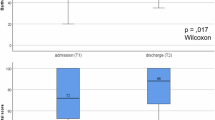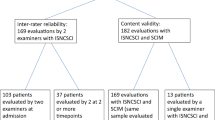Abstract
Study design
Retrospective chart analysis.
Objectives
To examine which professionals administered which assessment instruments in which patient in clinical practice during first rehabilitation after newly acquired spinal cord injury (SCI) and the differences in the frequencies of different assessments between patient groups.
Setting
Specialized SCI acute care and rehabilitation clinic.
Methods
Patients after SCI, aged 18 years and above, admitted for first rehabilitation between December 2014 and December 2015 were analyzed. Descriptive statistics of 54 selected assessments. p values based on the χ 2 test were calculated for assessments used in both paraplegic and tetraplegic patients.
Results
One hundred and nineteen patients were screened. Forty-one assessments were administered, of which 10 on average more than once per patient. The most frequently used assessments were Spinal Cord Independence Measure III (7.7 times per patient), Skin Assessment (3.6 times), and Manual Muscle Test (3.2 times for Lower Extremities; 2.5 times for Upper Extremities). The American Spinal Injury Association Impairment Scale was administered on average 1.9 times per patient. More variation in the number of assessments per patient was observed in patients with complete and incomplete lesions compared to patients with paraplegia and tetraplegia.
Conclusion
Assessments covering neurological functioning, mobility, and self-care are used in clinical practice during first rehabilitation of patients with SCI, while others covering autonomic functioning, pain, participation, or quality of life are still missing. Based on these observations and national and international requirements, a meaningful standard for an assessment toolkit, applicable in general and in specific subgroups, needs to be defined and implemented.
Similar content being viewed by others
Log in or create a free account to read this content
Gain free access to this article, as well as selected content from this journal and more on nature.com
or
References
Turner-Stokes L, Williams H, Sephton K, Rose H, Harris S, Thu A. Engaging the hearts and minds of clinicians in outcome measurement—the UK Rehabilitation Outcomes Collaborative approach. Disabilility Rehabil. 2012;34:1871–79.
Stucki G, Zampolini M, Juocevicius A, Negrini S, Christodoulou N. Practice, science and governance in interaction: European effort for the system-wide implementation of the International Classification of Functioning, Disability and Health (ICF) in Physical and Rehabilitation Medicine. Eur J Phys Rehabil Med. 2017;53:299–307.
Chan CWL, Miller WC, Querée M, Noonan VK, Wolfe DL. The development of an outcome measures toolkit for spinal cord injury rehabilitation. Can J Occup Ther. 2017;84:119–29.
Prodinger B, Ballert CS, Brach M, Brinkhof MWG, Cieza A, Hug K, et al. Toward standardized reporting for a cohort study on functioning: The Swiss Spinal Cord Injury Cohort Study. J Rehabil Med. 2016;48:189–96.
Prodinger B, Cieza A, Oberhauser C, Bickenbach J, Üstün TB, Chatterji S, et al. Toward the International Classification of Functioning, Disability and Health (ICF) Rehabilitation Set: a minimal generic set of domains for rehabilitation as a health strategy. Archiv Phys Med Rehabil. 2016;97:875–84.
Grimby G, Melvin J, Stucki G. The ICF: a unifying model for the conceptualization, organization and development of human functioning and rehabilitation research. J Rehabil Med. 2007;39:273–344.
Ballert CS, Stucki G, Biering-Sørensen F, Cieza A. Towards the development of clinical measures for spinal cord injury based on the International Classification of Functioning, Disability and Health with Rasch analyses. Arch Phys Med Rehabil. 2014;95:1685–94.
Fekete C, Boldt C, Post M, Eriks-Hoogland I, Cieza A, Stucki G. How to measure what matters: development and application of guiding principles to select measurement instruments in an epidemiologic study on functioning. Am J Phys Med Rehabil. 2011;90:S29–38.
Chhabra HS. ISCOS textbook on comprehensive management of spinal cord injuries; 2015. ISBN-13: 978–93 (Lippincott Williams & Wilkins, Philadelphia, USA).
van Hedel HJ. Improvement in function after spinal cord injury: the black-box entitled rehabilitation. Swiss Med Wkly. 2012;142:w13673.
Steiner WA, Ryser L, Huber E, Uebelhart D, Aeschlimann A, Stucki G. Use of the ICF model as a clinical problem-solving tool in physical therapy and rehabilitation medicine. Phys Ther. 2002;82:1098–107.
Anderson K, Aito S, Atkins M, Biering-Sørensen F, Charlifue S, Curt A, et al. Functional recovery measures for spinal cord injury: an evidence-based review for clinical practice and research: report of the national institute on disability and rehabilitation research spinal cord injury measures meeting. J Spinal Cord Med. 2008;31:133.
Dorjbal D, Cieza A, Gmünder HP, Scheel-Sailer A, Stucki G, Üstün TB, et al. Strengthening quality of care through standardized reporting based on the World Health Organization’s reference classifications. Int J Qual Health Care. 2016;28:626–33.
Alexander MS, Anderson KD, Biering-Sorensen F, Blight AR, Brannon R, Bryce TN, et al. Outcome measures in spinal cord injury: recent assessments and recommendations for future directions. Spinal Cord. 2009;47:582–91.
SCIRE. Spinal Cord Rehabilitation Evidence. Vancouver, BC: SCIRE Project/Monkey Hill Health Communications. 2016. [cited 2012 06.01.2017]. http://www.scireproject.com.
Biering-Sorensen F, Alai S, Anderson K, Charlifue S, Chen Y, DeVivo M, et al. Common data elements for spinal cord injury clinical research: a National Institute for Neurological Disorders and Stroke project. Spinal Cord. 2015;53:265–77.
Biering-Sørensen F, Charlifue S, DeVivo MJ, Grinnon ST, Kleitman N, Lu Y, et al. Using the spinal cord injury common data elements. Top Spinal Cord Inj Rehabil. 2012;18:23–27.
Post MW, Kirchberger I, Scheuringer M, Wollaars MM, Geyh S. Outcome parameters in spinal cord injury research: a systematic review using the International Classification of Functioning, Disability and Health (ICF) as a reference. Spinal Cord. 2010;48:522–8.
Biering-Sørensen F, Alexander M, Burns S, Charlifue S, DeVivo M, Dietz V, et al. Recommendations for translation and reliability testing of international spinal cord injury data sets. Spinal Cord. 2011;49:357–60.
Post MW, Brinkhof MW, von Elm E, Boldt C, Brach M, Fekete C, et al. Design of the swiss spinal cord injury cohort study. Am J Phys Med Rehabil. 2011;90:S5–16.
Brinkhof MWG, Fekete C, Chamberlain JD, Post MW, Gemperli A. Swiss national community survey on functioning after spinal cord injury: Protocol, characteristics of participants and determinants of non-response. J Rehabil Med. 2016;48:120–30.
SwiSCI. Swiss Spinal Cord Injury Cohort Study—SwiSCI, 2017. [cited 2017 14.02.2017]. https://www.swisci.ch/de/.
EMSCI. European Multicenter Study about Spinal Cord Injury, 2017. [cited 2017 14.02.2017]. http://emsci.org/
ANQ. Nationaler Verein für Qualitätsentwicklung in Spitälern und Kliniken 2017. [cited 2017 14.02.2017]. http://www.anq.ch/de/rehabilitation/messergebnisse.
Organization WH. ICD-10: International statistical classification of diseases and health-related problems. Geneva: WHO; 1992.
Prodinger BS-SA, Escorpizo R, Stucki G. UEMS PRM ICF Workshop moderators and rapporteurs. European initiative for the application of the International Classification of Functioning, Disability and Health: development of clinical assessment schedules for specified rehabilitation services. Eur J Phys Rehabil Med. 2017;53:319–32.
Hadley MN, Walters BC, Aarabi B, Dhall SS, Gelb DE, Hurlbert RJ, et al. Clinical assessment following acute cervical spinal cord injury. Neurosurgery. 2013;72:40–53.
Itzkovich M, Gelernter I, Biering-Sorensen F, Weeks C, Laramee M, Craven B, et al. The Spinal Cord Independence Measure (SCIM) version III: reliability and validity in a Multi-Center International Study. Disabil Rehabil. 2007;29:1926–33.
Whiteneck G, Gassaway J, Dijkers MP, Heinemann AW, Kreider SED. Relationship of patient characteristics and rehabilitation services to outcomes following spinal cord injury: the SCIRehab Project. J Spinal Cord Med. 2012;35:484–502.
Scheel-Sailer A, Wyss A, Boldt C, Post MW, Lay V. Prevalence, location, grade of pressure ulcers and association with specific patient characteristics in adult spinal cord injury patients during the hospital stay: a prospective cohort study. Spinal Cord. 2013;51:828–33.
Karlsson AK, Krassioukov A, Alexander MS, Donovan W, Biering-Sorensen F. International Spinal Cord Injury Skin and Thermoregulation Function Basic Data Set. Spinal Cord. 2012;50:512–16.
Krassioukov A. Autonomic function following cervical spinal cord injury. Respir Physiol Neurobiol. 2009;169:157–64.
Fekete C, Segerer W, Gemperli A, Brinkhof MW. Participation rates, response bias and response behaviours in the community survey of the Swiss Spinal Cord Injury Cohort Study (SwiSCI). BMC Med Res Methodol. 2015;15:80.
Acknowledgements
We thank the interdisciplinary team and the diverse health professionals for their assistance with the data collection. We also thank Daniel Apap for his precious comments and the English revision.
Author information
Authors and Affiliations
Corresponding author
Ethics declarations
Conflict of interest
The authors declare that they have no conflict of interest.
Electronic supplementary material
41393_2017_39_MOESM1_ESM.docx
Supplementary file: Comparison of average application of assessments in relevant subgroups of patients with paraplegia vs. tetraplegia and complete vs. incomplete lesion, n=119
Rights and permissions
About this article
Cite this article
Lampart, P., Gemperli, A., Baumberger, M. et al. Administration of assessment instruments during the first rehabilitation of patients with spinal cord injury: a retrospective chart analysis. Spinal Cord 56, 322–331 (2018). https://doi.org/10.1038/s41393-017-0039-x
Received:
Revised:
Accepted:
Published:
Issue date:
DOI: https://doi.org/10.1038/s41393-017-0039-x
This article is cited by
-
International Standards for Neurological Classification of Spinal Cord Injury: factors influencing the frequency, completion and accuracy of documentation of neurology for patients with traumatic spinal cord injuries
European Journal of Orthopaedic Surgery & Traumatology (2019)



